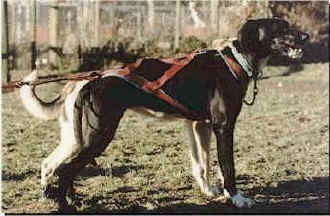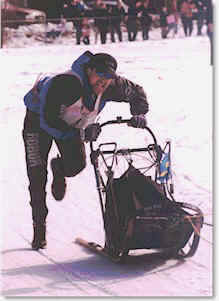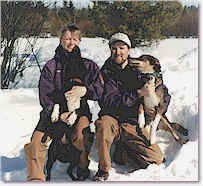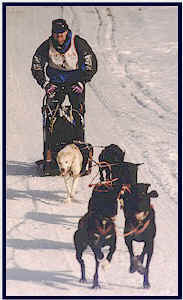Meet Egil Ellis
Exceptional "Scandinavian Hound" Racer

Part 2
Name:
Kennel Name:
Birthplace:
Home Town:
Occupation:
Web Site: |
Egil Ellis
Ellis Racing Sleddogs
Sweden
Willow, Alaska, USA
Professional Dog Musher
Egil's Facebook Page |
Part 1 of Egil's Interview
What is the training/racing philosophy of your
kennel?
To get a winning team! Happy dogs that run because they love it. I believe that a dog that
is healthy, well fed, trained for their task and well taken care of will also perform at
its best. All our training is done with positive reinforcements and never asking for more
than what the dogs can do.

Kitt, one of Egil's main leaders, sister to Mike
Do you have specific training goals for your team(s)?
Summer conditioning is done on a walker. That
keeps the dogs in fairly good shape during the off season. The dogs are walking until the
end of September and by then they have about 250 kilometers on the walker. By the time we
start taking them out with the 4-wheeler they are pretty well muscled and conditioned.
This makes the tough 4-wheel training a lot easier on their bodies. October and the two
first weeks of November I train with the 4-wheeler. Usually we donīt do more than 12
kilometers on gravel before we go on snow with sled. Before the racing season starts in
January I like to have a few long (35 kilometers) runs with the team to see how they react
on the distance.

Kick to the finish 3rd day
of the 1998 ONAC |
How do you choose which races to enter?
We try to do one or two local races in the beginning of the season for the
yearlings to get a feel of racing before we go to the main races. After that we go for the
big ones. I have one main race every season that I try to peak for. What does
it take to win?
Good dogs and to be prepared on all levels. Best training, best feeding, best
care, best equipment and all of the thousands of little details that can make a big
difference when it all has to come together on one weekend. A good economy and lots of
hard work. There are no shortcuts to victory! |
What is your vision of the future of sled dog
sports?
I am only 28 years old so I hope I will be around when the sleddog sport becomes
a member of the Olympic family. That I think would be a big thing for our sport. I also
hope that in the future it would be easier and cheaper for mushers to travel back and
forth between Europe and North America.
What can individual mushers do to support and promote the sport?
Be a good representative of our sport on races and at home. Take care of your
dogs and treat them good so that people from outside get a good view of our sport. As a
dog musher you are always an ambassador of the sleddog sport!
What part do clubs and organizations play in sport development?
Clubs play an important role in our sport to organize races and events and teach
junior mushers about mushing. The international politics also are important factors, but
that I leave to my wife, who is in the council of the IFSS board. |

Egil & Helen at Winter Camp |
Tell us about one or two of your most memorable
sled dog experiences:
For me the 1998
Open North American was a long time dream come true. This was the race that I had been
reading all about and following closely every year for as long as I can remember. I
didnīt know what to expect from trail conditions, longer distances and the new
competition. Before the race I had hopes for placing among the top 8 teams and I knew this
was possible if I didnīt make too many mistakes. I knew the dogs would do fine but I
needed more experience myself and I also got it!

Egil's Super 7,
3rd day 1998 ONAC |
The biggest difference of racing in Alaska compared to Europe are the
trails. Our trails in Europe are often hilly and have looser snow which makes it fairly
heavy for the dogs. The dogs have to pull hard all the time. What I realized when I got
to Alaska on those extremely hard trails was that I had to try and teach the dogs to run
without pulling. The trails where so hard that there was no resistance from the sled like
we are used to. When I took my foot off the ground and started pedaling, my dogs seemed to
lose their balance and tried running faster and faster to feel the pull in their lines.
This way it was hard for me to get a nice, easy rhythm in the team. But we learned a lot
and will be trying new things for next year and hopefully improve our results. |
|
The weekend after the Open NAC I had another good racing experience in
Alaska. At the Tok Race of Champions I felt that I knew my team better and which dogs
had adapted fully to the Alaska trails. In Tok I started with only 12 dogs the first day
and had 10 the second day. Here I recognized the team that I was used to from training
runs earlier in the season. The team had recovered fully from the NAC and had come back
stronger. I had two very good runs with no stops or any problems. It was a good feeling to
let the dogs show what they are capable of doing. Now I just have to get more of the same!
Simple as that...
Best regards / Egil Ellis
 More photos of Egil's dogs and kennel setup More photos of Egil's dogs and kennel setup


Part 1 of Egil's Interview
Egil's Facebook Page
[back to Interview list]

top of page |
home |
feedback | search

|



